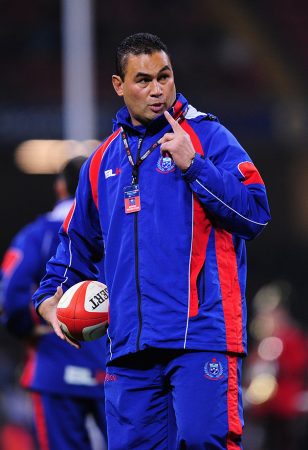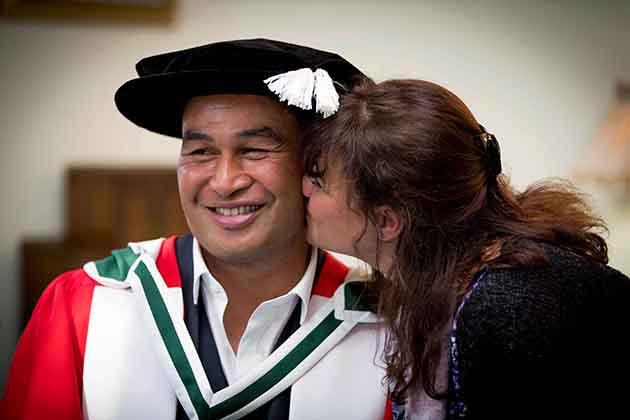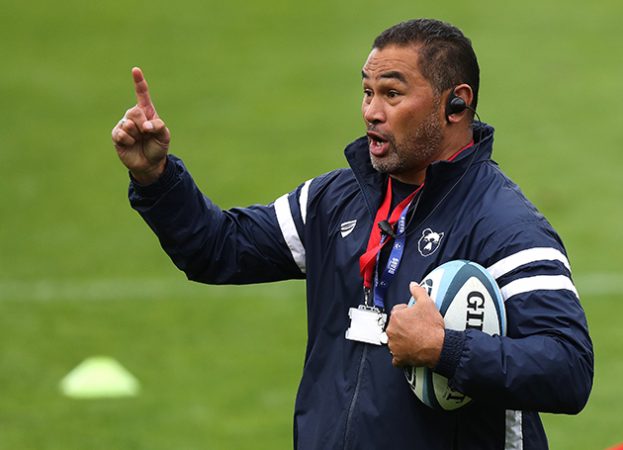The Bristol Bears boss has packed a lot into his 30 years as an elite-level player and coach
Pat Lam’s Life in Pictures
Pat Lam won 34 Samoa caps between 1991 and 1999, playing in three World Cups during that time. The back-rower also won trophies with Newcastle and Northampton before moving into coaching and winning trophies with Auckland, Connacht and Bristol.
Here Lam talks through key moments from his three decades in the elite game…

(Getty Images)
1991 – Island paradise
“The biggest highlight of my playing career – the 1991 World Cup and beating Wales (16-13). It was a massive game and a huge upset, but the reason why it’s the highlight is what it did for the Samoan people.
“Growing up in New Zealand, Samoans were seen as working class, working in factories and so forth. What that Samoa team did gave them a sense of pride.
“I was a teacher and every young Pacific Islander growing up in New Zealand wanted to be an All Black, but after that it was, ‘Mr Lam, I want to play for Manu Samoa’. It brought real pride.
“What the team achieved on the field meant Samoa then got invited to play the big nations.”

(Getty Images)
1992 – Making a splash
“You can’t change countries now but in those days you could. I was with New Zealand Sevens from 1989 so this was my fourth year in that team, while I’d been to the 1991 World Cup with Samoa.
“The 1992 Hong Kong Sevens was difficult because that year we played Samoa in one game, so there were mixed emotions.
“The weather was also atrocious – we couldn’t do scrums, only free-kicks, because of the puddles of water. Every child wants to play rugby in those conditions, running and sliding everywhere!
“I scored a try in the corner here and they were just unforgettable conditions – I’d never played in conditions like that before.”

(Getty Images)
1998 – Lovely bubbly
“I remember this very clearly. We were at the Stoop playing Quins on a Sunday. Saracens had been one point behind us and had won, so we needed to win and we won really comfortably in the end.
“Newcastle football club was also owned by Sir John Hall and they were playing Arsenal in the FA Cup final at Wembley on the Saturday, so a lot of the Toon Army came along to support us as well.
“It was a great day, to go from getting promoted the year before to winning the Premiership. We had a lot of internationals and a lot of good friends, and to win the Premiership was massive for rugby in the North of England.
“Some of us also went to see the Spice Girls on the Friday night and we were asked by security to move back because the little girls couldn’t see above us! We got to meet them and, this was before he was famous, Baby Spice thought Jonny Wilkinson was very cute.”

(Getty Images)
1999 – Lam sandwich
“I retired at the end of this World Cup, when we were the first team to win at the Millennium Stadium and Wales had won ten Tests in a row. The final score was 38-31 – it was a great game. We’d put a lot of work in to try to beat them and everything came off.
“I scored from an intercept. Ed Morrison was the referee and as I was playing in the Premiership I knew him. Wales had made a line break and we were in big trouble, they looked like they were going to score. I was running back and I gave Ed the heads-up to say I was onside, then I remember rushing up inside Scott Quinnell.
“Neil Jenkins got the ball and passed to Scott, but I got in between them and intercepted. I ran in from 80m, maybe 60m, but it was a big run. That was the beauty of playing in the Premiership; Wales were saying I was offside but I’d shown Ed I was onside.
“The Millennium Stadium is my favourite stadium. Even in 1991, at the Arms Park, the atmosphere was unreal and the Millennium magnified that under the roof.
“I’d played in three World Cups and knew I wouldn’t go to 2003. I’d also been captain from 1995 through to 1999, so I thought it was right to step down so Samoa could bring the next group through as I’d been involved for so long.
“It had also been tough on my family, playing in the Premiership and then flying back to New Zealand or Samoa for Test matches, then back again – it was non-stop. It was time to focus on playing for Northampton and having time with my family.”

(Getty Images)
2000 – Saints’ day
“This was a very good day (beating Munster in the Heineken Cup final). Northampton hadn’t won anything in their 120 years.
“I had no desire to go to Northampton, I was very happy at Newcastle, but I got sold and Ian McGeechan bought me. I wasn’t pleased at first but I learnt a lot from the great Ian McGeechan.
“We had a lot of talented players but the big thing we did was bring a culture together of being more like brothers than men. We achieved some big things. In those days there weren’t breaks for the European Cup, so the more successful you were, the more midweek games you had.
“I wasn’t sure if I’d play because we were expecting child number four on the day of the final.
“Munster were favourites and that week we didn’t train because we were battered and bruised. We said it would come down to heart and mental toughness, and we had one more game left in us. It was a close game, 9-8.
“We were in contention for three trophies, lost the other two but got the big one. It was a huge day and a special team.”

(Getty Images)
2001 – Two sides
“This was my last season, back at Newcastle to finish off my career. I had about 20 offers for two- or three-year contracts, but I only wanted to play one more year so I made the decision to go to Newcastle. I hadn’t wanted to leave (in 1998), so I went back to finish there. It gave me peace to leave on the right note.
“Whenever I’m doing photos I’m asked to be serious but that’s not me. Most Pacific Islanders are like that: on the field we’ll be tough but off the field that doesn’t reflect who we are. They wanted me and Johnno (Martin Johnson) to stare each other out but I was laughing.
“When Bristol wanted to change to the Bristol Bears I liked that as it’s similar – bears protect their community but they will fight when they need to be aggressive. I want aggressive, tough rugby players but I also want a gentler side – working with young people, going into hospitals.”

(Getty Images)
2002 – Final flourish
“My last-ever game was for the Barbarians against Wales and I was given the honour of captaining the team. We were losing 25-0 at half-time but won 40-25 and I scored the last try.
“I love the Barbarians. I came through in the amateur days but professionalism isn’t about getting paid, professionalism is the way you do things. Playing for the Barbarians was a throwback to the amateur days, coming together to just play rugby with friends, to socialise and have a great time.
“I’ve also been privileged to coach them and because I understand what the Barbarians is about I pass that on.”

(Getty Images)
2003 – Masterclass
“I’d started working with Scotland in 2001. Two weeks after I started my last season at Newcastle, Graham Henry called to ask if I’d be an assistant for Wales. Graham had coached me since I was at school and had been a big part of my career, but I told him I’d just signed for Newcastle so we said maybe the next year when I finished playing.
“Two weeks after that Geech (Sir Ian McGeechan) got hold of me to ask if I’d help with Scotland. I said the same thing, that I’d just signed with Newcastle, and he said, ‘It’s only an hour or so away’.
“We had breaks in the season for the Six Nations and autumn Internationals then, so he talked to Rob Andrew, the director of rugby at Newcastle, and Rob gave his blessing for me to do it. He knew I had a desire to coach and it was a transitional stage before retiring. Graham was really understanding too. I learnt a lot from him and a lot from Geech.
“Geech was fantastic and mentored me in every part – playing, man-management, ideas on the game. I was like a sponge, picking everything up.
“After I retired he offered me a full-time job, but by then Steph, my wife, thought it was time for us to go back home (to New Zealand). Geech told me to take my family home and that he’d fly me back for the Six Nations, June Tests, November and so on. It meant when I was at home it was family time, then when I was in Scotland I was living and breathing the team. That took me through to the 2003 World Cup.”

(Getty Images)
2007 – Winning run
“After the 2003 World Cup, Graham Henry asked me to work with him at Auckland. He then got the All Blacks job and I came in as head coach when I was supposed to be assistant.
“This was my fourth year with them and it was a special year. We had a great group of guys, like David Smith and Jerome Kaino here. So many young players came through and we set a record by winning every single game to go undefeated.
“We won the Ranfurly Shield in Christchurch against Canterbury, which was massive, and the Air NZ Cup. It was a great season.”

(Getty Images)
2012 – Blues blow
“If I had to pick a year where I grew most as a coach it would be 2012. I got so many lessons to take forward. Until you’ve been sacked nothing is real for you. Once that’s happened it forces you to review and reflect, to prepare for the next step.
“The year before, in 2011, the Blues reached the Super Rugby finals – we lost to the Reds in the semis and they went on to win it.
“That year we weren’t doing well for a variety of reasons but there’s an undercurrent in New Zealand that comes through when something goes wrong… There’s Polynesian flair but Pacific Islanders aren’t in thinking positions. Yet in 2007 with Auckland, we’d won with a Tongan captain, Sam Tuitupou, and Pacific Islanders at nine, Taniela Moa, and ten, Isa Nacewa, and at No 8 was Jerome Kaino!
“People were making racial comments (in 2012). It didn’t bother me but it did bother my mum and dad. They would listen to talkback radio, where people would just vent about rugby.
“At that media conference someone asked about my parents. I started talking about my dad and got emotional, people not understanding his background of coming from Samoa to New Zealand on a boat at 19. Even now I’m getting emotional. I talked about how tough it was for my dad and broke down a little bit.
“I turned to our media person and said, ‘This will blow up’ and it did. It was all Pat Lam and racism, it’s getting too much for him (one headline read: Pat Lam breaks down over racist taunts). But it was talking about my dad that did it.”

(Getty Images)
2012 – Familiar story
“I was sacked as Blues coach in July and then Samoa asked if I’d help out as technical adviser for their November tour.
“We were playing Canada, Wales and France, and a lot of the management hadn’t been to the northern hemisphere.
“We talked about how to run that tour because we had 30 players in the squad, with not one from the same club. We had six training sessions so had to keep things simple to be effective.
“We beat Wales to form the ‘Pool of Death’ at the 2015 World Cup (as Wales fell out of the top eight in the rankings that autumn).
“To win at the Millennium Stadium was fantastic and continued my relationship with Wales, beating them in 1991, 1994 and 1999 as a player and then again as a coach in 2012.”

(Inpho)
2015 – The big chill
“We’ve got a world map at home with pins for all the places we’ve been. There’s one dot in the middle of Russia – Krasnoyarsk (where Connacht faced Enisei STM in the Challenge Cup).
“It was minus 29°C. The plan was to fly in and fly out but our plane broke down, we got stranded for a couple of days and we all had to come back different ways. It was a real experience and something I’ll never forget.
“It was the making of the group. We faced a lot of adversity and challenges on that trip, but we embraced it and came out stronger. That held us in good stead to win the (Pro12) title.”

(Inpho)
2016 – Crowd pleasers
“We brought the community along for that ride. Connacht had been close to being disbanded but we brought the whole province together. They got behind what we achieved (winning the Pro12).
“That’s my coaching highlight. We didn’t have the best players or the best budget, but it was a true team effort; everyone did their bit.
“It was Connacht’s first final whereas Leinster had been to so many and were pretty much the Irish national team, but we played with no fear. We went in full of confidence, played our game and scored some unbelievable tries.
“We landed at Knock airport at 2am but it was full of people and all the way back people were on the streets, then we brought the trophy to our training ground. This was a highlight because of what it did for the community. There was so much pride.”

(Inpho)
2016 – Happy couple
“We’ll have been together 33 years in December of this year. Steph’s the best – there’s no way I’d have been able to do what I’ve done and what I do if she wasn’t the person she is. She’s an unbelievable people person.
“When I got the opportunity to play in England, she said, ‘Let’s go’. It was the same when we went to Ireland, all these different places. Everywhere we’ve gone, she loves meeting people and doesn’t like anyone being left out.
“She’s a special person and a big part of who I am. She’s the main reason I do what I do.”

(Getty Images)
2018 – Bouncing back
“I’m not in the photo – those celebrations are for the players and I’d had those when I played.
“It was a difficult decision to leave Connacht to go to Bristol. When I signed in December they were in the Premiership but by the time I arrived they were in the Championship. That wasn’t part of the five-year plan and it was a tough battle (to get promoted) but it gave me time to get to know the team and implement things.
“I also signed a few guys out of the Championship and I wouldn’t have known those players if we hadn’t been playing them. It was a really good foundation year.”

(Getty Images)
2019 – On the up
“We experienced some adversity when we started in the Premiership; we were on the up and then got hammered by Worcester, which showed we weren’t where we wanted to be. Still, in that first year we were only five points away from the top six.
“This photo, with Callum Sheedy, shows the growth to where we are now. Before Covid, we’d won five games in a row, which was a club record, and it’s a reflection of how far the group has come. Someone like Callum, who has come from the academy, is home-grown and displaced Ian Madigan, gives an insight into what we’re about.”
Related: Get to know Bristol Bears fly-half Callum Sheedy

(Bristol Bears/JMP)
2020 – Back to back
“There’s huge enjoyment in being back after lockdown and we’re proud of our new facilities. Although they’re brand spanking new, what makes them world class is the work we do in them and the relationships we build, otherwise it’s just a lovely building.
“What I said to the players was that the previous place wasn’t class at all but we made it world class by our actions. Now we can take things to another level and that goes back to the ambition of our rugby programme – quality staff, quality players, world-class facilities. It’s a dream coming in – the view, the greenery… It’s the best facility I’ve ever been in.”
This article originally appeared in the October 2020 edition of Rugby World magazine.
Follow Rugby World on Facebook, Instagram and Twitter.





